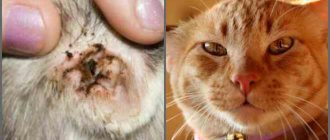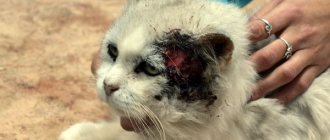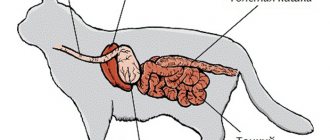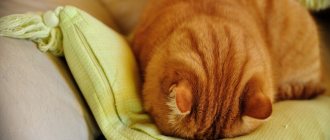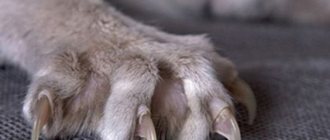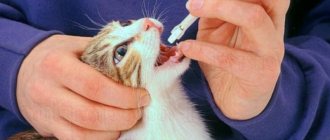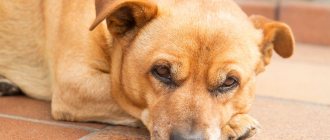Ringworm in cats are sores on the body. Once upon a time, this disease was considered incurable and those infected were simply euthanized. Today, although it is common, it often goes away on its own, without the help of doctors. However, this does not mean that you can ignore it. It is very important to notice signs of lichen in cats in the early stages and immediately take your pet to a doctor. Unlike many other diseases, the fungus is transmitted to humans through simple contact.
How to identify ringworm in a cat
Ringworm is a general name for many diseases in which areas of the body appear covered with a rash. At the same time, hair falls out from the sore spot. There are several causes of the disease: from a virus or allergy to a banal deterioration of the immune system. If you have other pets in your home, they can quickly become infected. This is especially true for dogs or rodents with which the cat comes into contact.
Infection occurs very quickly; the patient does not have to rub against the hamster for it to become covered in a rash - the fungal spores spread through the air. If you let your cat outside, he probably became infected from homeless friends.
But even exclusively pets can become infected - it’s not a fact that your guests could not bring the infection with them in their hands by petting a street cat or their own. Any animal can carry an infection, even if it itself is not sick.
Ringworm can be treated quickly enough. If the owners notice scratching on the pet’s skin in time, with proper care, the problem will disappear in 2-3 weeks. But an advanced disease does not disappear for up to several months. After the pet has fully recovered, it is necessary to protect it from contact with people for another 2-4 months. During this period, he is still contagious, but there are no longer any signs.
Features in children
Children aged 4 to 12 years are a particular risk group for infection with this form of the disease. A child can become infected with a dangerous virus simply by playing in the sandbox, or by petting a street dog or cat. Therefore, if suspicious spots appear on a child’s body, you should immediately consult a doctor.
In order for recovery to occur as quickly as possible, you must follow a few basic rules.
The first thing, of course, is to exclude the child from contact with animals on the street.
The second thing to do is to refrain from frequent water treatments in the bathroom; just limit yourself to water from the shower.
Third, remove sources of allergens in the baby’s room: soft toys, carpets, etc. Wet cleaning of the room and ironing of the child’s personal belongings help eliminate harmful microorganisms.
Why does lichen occur?
Here are some of the main reasons why lichen develops in cats:
- the cat has free access to the street, where he spends a lot of time unsupervised;
- treatment in the near future was carried out using various immunosuppressants;
- problems with diet, lack of vitamins, unbalanced diet;
- infectious diseases that suppress the immune system;
- tumors and other malignant formations.
But these are only factors contributing to infection, and the main source is one - fungal spores. They first land on the fur, where they quickly multiply, reaching the skin. Heat and moisture create the most suitable environment for this. Usually, a cat’s strong immunity destroys the infection as soon as it barely reaches the skin.
But if the immune system is not enough to stop the infection, then lichen in cats will spread throughout the body at incredible speed. Kittens and young individuals under 2 years of age are most susceptible to this, since their immunity has not yet been properly formed. Well, some breeds do not have immunity to infection at all. These include, for example, the Persians.
Treatment
The regimen and duration of therapy depend on the type of lichen. In any case, to relieve the external manifestations of the disease, the cat will be prescribed symptomatic treatment, as well as means to enhance immunity.
Symptomatic agents for external use are drugs that have a fungicidal (antifungal), antiseptic, keratolytic (softening) effect: YaM BK ointments, Sanoderm, Miconazole, Clotrimazole, Fungin, Epacid-alpha sprays.
If the lichen occurs in a protracted form, the cat may be prescribed oral medications: Griseofulvin, Itraconazole or Terbinafine. The duration of their use and dosage are calculated individually, taking into account the weight and age of the cat.
It is strictly forbidden to bathe a cat using regular shampoos if it shows signs of lichen: with water, fungal spores can easily spread to the entire body of the animal. For hygiene procedures, the doctor can prescribe special medicated shampoos for your pet: Veterinary Formula, Nizoral, Zooshampoo, Sebozol.
Varieties of lichen
There are several different types of lichen in cats, which differ not only in the nature of their occurrence, but also in appearance. What does lichen in cats look like depending on its type?
Ringworm in cats
Its cause is the fungus described above. This species is the most dangerous, as it incredibly quickly infects surrounding people and animals. This is especially true for children, who often suffer from a similar illness simply by stroking the carrier. But even this is not necessary, because the bacteria are incredibly hardy and can live outside the body for several years. In the house they feel great on a variety of textile surfaces.
Variegated, also called pityriasis
This variety is also transmitted from pet to person, but is no longer as common as the ringworm. The spores are most active in the summer, when the body receives excess vitamin D. Interestingly, almost all people and animals on the planet are carriers of the pathogen. And only in rare cases is it able to develop into a pathology that manifests itself in domestic animals. In hot weather, the work of the sebaceous glands is disrupted, the oiliness of the skin increases and a favorable environment is created for the development of the pathogenic form.
Pink
This lichen in cats appears only when the immune system is weakened. Although this species is considered harmless to humans, scientists have not yet come to a consensus on this. Most likely, the pink type occurs due to the entry into the body of a virus that has not been fully studied by humans. In addition, it is known that it is hereditary, and after complete recovery it comes in a new wave. It is not recommended for children, the elderly, or people with weakened immune systems to have contact with an infected cat.
Weeping eczema
Weeping eczema is an allergy to some external factor. It occurs in pets when they change their place of residence or living conditions. Not contagious to people. If you notice your cat has eczema, pay attention to whether you have used any new detergents, air fresheners or other household chemicals. If external signs cannot be identified, contact your veterinarian; the problem may be excessive stress or hormonal imbalance.
Is it contagious and how is it transmitted?
Feline ringworm is an infectious disease that is transmitted mainly from animals to humans. But microsporia can also be contracted through household means. Household items such as a towel or comb can become carriers of the disease. The fungus hides for a long period in sources of allergens: carpets, clothes, soft toys and becomes active at the right moment.
Fungal spores often float in the air, settling on tiny particles of dust or fur. Even dandruff can serve as a carrier of the disease. You can become infected with microsporia through the soil, working in your summer cottage without gloves. Fungal spores are characterized by increased viability and can hide in different environments for about two years.
Symptoms of the disease
Although each species is different, they have both common and individual signs of lichen in cats. General symptoms:
- hair loss in areas where the rash appears;
- inflammation, redness, dryness of the epidermis;
- constant severe itching.
Also, each species has separate, characteristic features.
Symptoms of ringworm
If your pet has contracted ringworm, there are several ways to identify it. Some parts of the fur will quickly fall out, but the rest of the coat will remain unharmed. Before this, the development of a small red rash on the body will begin. Because of them, the cat may itch for a long time. Often he finds no rest or suddenly wakes up from an attack of itching.
More developed lichen in cats can be determined by the following signs:
- the cat develops round spots covered with a crust of flaky skin;
- These areas are not covered with hair, and the hairs nearby thin out and become more brittle;
- if during the scratching process the cat scratches off part of the crust, a red smooth surface will be visible under it;
- over time, the spots increase in size and take on an oval or round shape;
- If the disease is not treated for a long time, hair will no longer grow at the sites of inflammation, as hard scabs will form.
The spots often cause discomfort and itch for animals. Depending on the pathogen, symptoms can affect the pet’s entire body or the head and neck separately. It also happens that some signs of lichen in cats are simply not expressed or are completely absent. This is called the apathetic form of the disease. In this case, only some hairs of the coat are susceptible to loss. Because of this, the disease becomes invisible to the naked eye, which means that the owner may not take any action to treat it for a long time.
Symptoms of pityriasis versicolor
Pityriasis versicolor in cats are pale, oval-shaped spots on the animal’s skin. They quickly spread throughout the body and after a few days occupy most of it. Then the spots begin to grow together, which can cause damage and deformation of the claws. In this case, the cat does not feel itching or any other severe discomfort. The spots may disappear if the surrounding temperature drops.
Symptoms of pityriasis rosea
Sometimes feline pityriasis rosea is confused with an allergy. The fact is that it appears as a small red rash on the skin. In some cases, the spots increase to 2 cm in diameter. A large accumulation of them is usually noticed on the pet’s stomach, in the groin and on the inside of the thigh. Itching is absent or almost not expressed.
The skin on which the spots appear becomes rough. If treatment has not begun for a long time, other microorganisms enter the lesions, which causes much more dangerous consequences, for example, sepsis. In some animals this is accompanied by fever, malaise, joint pain and swollen lymph nodes.
Signs of eczema
Weeping eczema is also characterized by red spots. But in this case, it hurts the pet when anything touches the lesions. The rash is small blisters with fluid inside. Sometimes they open, causing their contents to fall onto the surface of the skin. This is how infection and spread of the disease occurs. And although people should not be afraid of this disease, it sometimes causes febrile conditions in pets.
Signs of the disease in humans
The incubation period for lichen, which can be contracted from a cat, ranges from 2 days to 1.5 months. Most often, the disease manifests itself on days 6–8. Its symptoms differ depending on the location of the outbreak. In general terms, microsporia is represented by an oval pink spot with a rim of a darker color.
Without treatment, the number of plaques increases and they merge with each other. A person with lichen from a cat experiences slight itching in areas of redness.
Important! Feline lichen in humans most often develops when infected through contact and household contact. The use of personal equipment and good hygiene are very important.
Ringworm, which a person could contract from a cat, often affects the scalp. In this case, foci of infection will be represented by a reddened bald spot and a flaky center. And if left untreated, they will begin to increase in size and cause hair loss.
If lichen is transmitted from cats to children, it can become chronic. Moreover, girls are much more susceptible to it than boys. In boys, especially teenagers, it is characterized by a mild course.
Chronic microsporia affects:
- back of the head;
- shoulders;
- scalp;
- joints;
- palms;
- feet;
- nail plates.
Any skin changes are characterized by itching and flaking. Less commonly, a person may experience weakness, fever, and drowsiness.
What to do if your cat suspects lichen
First, of course, you need to isolate the animal from other pets and family. If living space allows, place it in a separate room or on an insulated loggia. There is absolutely no need to put your pet in a cage.
The second thing you should definitely do is contact your veterinarian so that he can conduct a diagnosis and confirm or refute your guesses about cat lichen. It will take very little time not only to identify the fungus, but also to identify its cause. Based on the data obtained, the doctor will prescribe an accurate and most effective medicine for lichen in a cat.
It is very important to know that bathing a sick person during this period is strictly prohibited. During the process, the spores spread throughout the animal’s body along with water, thereby affecting an even larger area.
Diagnostic methods
To diagnose the pathology, you should consult a dermatologist. He conducts an initial examination of the lesions.
To confirm the assumption of ringworm, the following studies are carried out:
- Inspection using a Wood's lamp emitting ultraviolet light. On the head, in areas affected by the fungus, the hair has a slight greenish tint. This method is good because it is possible to determine the disease, even if only one hair is infected.
- The diagnosis can be clarified using bacteriological examination. For scraping, hair scales and stumps are taken, which are examined under a microscope for the presence of microorganisms in them. Fungal spores and mycelium are usually found in the upper layers of the skin.
The areas affected by ringworm glow under a fluorescent lamp
It is also necessary to differentiate from skin pathologies with similar external signs:
- when the disease is localized on the scalp, differentiation is made with alopecia;
- the cutaneous location of ringworm should be distinguished from eczema and psoriasis;
- the chronic form is differentiated from candidiasis, acne, psoriasis and eczema of the nails, as well as lichen planus are excluded.
Diagnostics in a clinical setting
Detecting lichen in a cat in the early stages is not so easy. It all starts with a thorough examination by a veterinarian. As the owner of the animal, the doctor will ask you questions related to the general condition and will ask you to provide his medical record, if he has one. This is done in order to establish the cause of the disease as accurately as possible, and therefore prescribe the correct treatment for lichen in a cat. After the examination, you will need to undergo one or more examinations.
1. Wood's lamp
. It emits light in which infected areas are highlighted, making them easy to find. This type of diagnosis has several disadvantages. For example, not all types of mushrooms are sensitive to such light and are not illuminated at all. And harmless spore organisms that accidentally get on the wool can give a false signal.
2. Scraping
. A scraping or hair sample is taken from the affected area. The examination itself is carried out under a microscope, and the result will be told to you immediately. However, it is not always possible to find pathogenic organisms, and even the absence of a diagnosis does not guarantee that the cat’s health is in order.
3. The most accurate way to find a disease is to isolate the pathogen itself using a nutrient medium
. A skin sample is taken from the animal and placed in a compound where bacteria can grow freely. It will take some time to observe their development, after which a specialist will examine the grown fungus under a microscope. This method is quite accurate, but requires a lot of time. It takes 1 to 3 weeks to make a diagnosis.
In addition to all of the above, they will definitely take a blood test from the animal and check it for the presence of other diseases or parasites.
From a cat
The same answer is suitable here as for the question of whether lichen is transmitted from dog to person. The situation does not change with the cat. If she is sick, then a person can easily become infected through direct contact. In addition, even a cat that has recovered from the disease is a potential source of pathology.
Microspores could remain in the animal's fur, especially if it has high immunity. With single contact, infection often does not occur, but in this case it is still better to wash your shoes and wash your hands thoroughly with soap.
You should stay away from cats with strange spots on their faces.
How to treat a cat
Each type of cat lichen has its own treatment method. If the disease has not had time to spread significantly, you can be treated with a simple ointment, and in advanced cases you cannot do without long-term therapy with the use of potent tablets. What therapy the doctor will prescribe also depends on the breed of the cat, the strength of the immune system and the severity of the disease. In any case, only a specialist can decide how to treat lichen in a cat.
If the specialist's recommendations are properly followed, the rash goes away within 10-15 days, and the coat is completely renewed in another 2-3 weeks. It is important to remember that even if your pet appears healthy, pathogens can still live on it. Therefore, whether the cat is cured or not, only laboratory specialists will say after repeated tests.
Ringworm in cats is one of the most aggressive diseases, so it requires complex treatment using special antifungal ointments, shampoos, and tablets.
Before applying ointment or cream, it is necessary to shave the hair near the affected areas. This increases the effectiveness of the drug, because this way it does not remain on the hairs and is absorbed into the skin as much as possible.
Of course, it would be much more effective to use various vaccines in treatment, but they have many contraindications. For example, they cannot be used if the pet has a weakened immune system, has chronic diseases, or if the female is pregnant.
In cases where the disease is accompanied by severe itching, you first need to fight it. Treatment will be pointless if the animal constantly scratches the rash into the blood. Antihistamines are generally prescribed, and in rare cases, anti-inflammatory drugs. You need to give your cat tablets in precisely dosed portions as prescribed by your veterinarian. Taking the wrong amount of medication or not taking it on time can cause the lesions to spread.
In addition, the use of traditional medicine is acceptable. This is the only way out if the cat is pregnant, has recently suffered or is currently suffering from another serious illness. In such cases, medicinal herbs, iodine, and alcohol are usually used. Do not use traditional methods under any circumstances if the disease has already moved from the initial stage to later ones. Such treatment will be useless and harmful to the body.
Use one of these recipes if you want to use alternative remedies.
1. Pick fresh leaves of nettle, violet, string and oregano and mix. Steam two tablespoons of the resulting mixture with 200 ml of hot water, let cool and strain through a sieve or cheesecloth. Let your cat drink this 3-4 times a day before meals.
2. Mix chamomile flowers, horsetail, valerian root and licorice. Calculate 200 ml of water per 1 tablespoon and place in a water bath for half an hour. Give in the same way as the previous infusion.
3. Pour 30 ml of medical alcohol into a container, add 1 crushed aspirin tablet and treat the skin with this no more than once a week.
4. Also, wounds can be smeared with iodine, either in pure form or mixed with vegetable oil and valerian tincture.
Traditional medicine is often powerless against aggressive forms of lichen in cats. They can also blur the clinical picture, so never give your animal any medications before going to the doctor.
The use of folk remedies in the treatment of feline ringworm
Currently, medicine has made great strides in the diagnosis and treatment of fungal infections. In this regard, the role of folk remedies in the treatment of lichen has decreased significantly. However, you should not completely forget about them, because in combination with drug treatment they can be a good addition and speed up the recovery process.
- Chamomile decoction. Brew 20 g of dry inflorescences in 300 ml of boiling water, leave to brew for half an hour and rub into the scalp for a week. This will help quickly restore hair.
- Garlic. Cut a clove of garlic and rub it on the affected areas once a day. The bactericides contained in garlic will help you recover faster.
- Propolis tincture. Pour 50 g of propolis with 200 ml of alcohol and let it brew for several days. Wetting the tampon in the resulting tincture, treat the affected areas up to 5 times a day.
Ringworm in cats: drugs for treatment
During pregnancy and lactation, you need to be especially careful when choosing medications for the treatment of lichen, because some of them can harm the developing body. In addition, treatment should be started as early as possible to prevent the spread of the pathogen to the child. Therefore, in such situations, treatment is carried out strictly under the supervision of a specialist.
Important! The same symptoms are characteristic of several diseases at once.
Diagnosis of some diseases is difficult even in medical institutions. Don't try to diagnose yourself. You cannot take or use medications without a doctor’s prescription. When the first symptoms of the disease appear, you should immediately contact a specialist.
Prevention of skin diseases
Perhaps the surest way to prevent ringworm in cats and other species is vaccination. The fact is that almost all types of fungus are immune to antimicrobial drugs, and selecting an effective remedy based on one type of disease in the case of prevention is pointless. But vaccinations done on time will relieve you of worry for a long time.
In addition to regular vaccinations, there are a number of rules that should be followed to prevent your cat from getting sick:
- try to protect your cat from contact with unfamiliar, suspicious animals;
- always carefully treat every wound or scratch with a special antiseptic;
- Take your pet to the doctor regularly;
- Wash your cat's bedding or mat at least once a month, wash the bowl and other cat accessories weekly;
- Provide your cat with complete and balanced nutrition.
Constant care is the strongest shield against various diseases; every cat owner needs to remember this.
Risk factors and routes of infection
A cat can become infected with types of dermatitis that are caused by pathogenic fungi through contact with a sick animal or person through common objects.
Risk factors for developing lichen in cats:
- Free range, where contact with infectious animals is possible;
- Weakened immunity (including after suffering from viral diseases, stress or taking drugs that suppress the effect of the immune system);
- Age up to 1 year, when the cat’s immune system is not yet fully formed;
- Unbalanced diet (deficiency of proteins, fatty acids and vitamins);
- Parasitic diseases, in particular helminthiasis.
One of the risk factors is genetic predisposition. Cats whose breed was obtained through selection (for example, Persian, Sphynx) suffer from lichen more often.
Varieties and atypical forms
In medicine, two types of feline lichen have been identified. If the infection occurred from an animal to a person, the disease is called microsporia, but if the virus passed from person to person, it is called trichophytosis.
In total, more than 20 species of the Microsporum fungus are identified, among them several pathogenic groups are distinguished, in particular: atropophilic, zoophilic and geophilic groups.
Microsporia of the scalp can have the following atypical forms:
- the infiltrative form is expressed by the appearance of hyperemic spots, the outlines of which are somewhat elevated above the surrounding skin, and the hairs are broken off at a distance of 3-4 mm from the base;
- in the suppurative form, inflammatory processes are clearly expressed. In this case, you can see soft bluish nodules with pustules on the surface;
- exudative microsporia is characterized by the appearance of small bubbles, bursting, they form a dense crust;
- the trichophytoid form is distinguished by small lesions throughout the scalp. With this form of the disease, spots appear with pityriasis-like peeling, with unclear boundaries, without inflammatory signs;
- The seborrheic form is manifested mainly by partial hair loss, the lesions being covered with small scales.
How to recognize a sick animal
To warn your family against ringworm , you need to know which animal can bring danger. If there are various changes in the coat (hair loss, scratching, dandruff), you should be wary. Mostly, lichen is observed in pregnant and weak cats that have helminths.
On the skin of a quadruped, the formation of round, oval spots with a lack of hair is possible. Broken bristles are visible along the edges. Baldness is often noticed on the paws, tail, and head. The damaged area is reddish in color, peels, crusts or scales may be visible.
The pet feels discomfort due to burning and itching, so it itches constantly. At an advanced stage, the animal loses weight, its fur becomes dull, and indifference to everything appears.
Complications and consequences
If treatment is incorrect or untimely, unpleasant consequences may occur in the form of complications, and even death. Ringworm is an insidious and unpredictable disease; timely measures will help avoid many health problems. Among the most common complications are: blindness, tumor processes, hearing impairment, neuralgic symptoms, viral pneumonia and even meningitis. In case of damage to the scalp, there is a risk of hair loss without the possibility of hair restoration.
Treatment of complications is a long process, so it is necessary to follow preventive measures and start treatment in a timely manner.
Kinds
Science distinguishes between two types of disease. If a person becomes infected from an animal, then the disease is called microsporia, but if a person infected a person, then trichophytosis. Scientists have identified more than 20 types of the causative agent of lichen, which are divided into pathogenic groups (zoophilic, geophilic, atropophilic). Depending on the symptoms that characterize the disease, doctors distinguish several types of it:
- Surface type. The spots appear on open areas of the skin and go away without complications. If the patient receives treatment, the disease disappears within 3-7 days.
- Erythematous-edematous type. Swollen, red, scaly spots appear on a person’s skin, which itch and cause discomfort. The disease is more often diagnosed in children and young women.
- Deep type. Pathogenic microorganisms penetrate deep into the skin, forming spots on the legs covered with keratinized scales.

